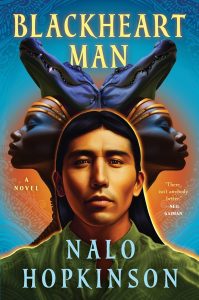Gary K. Wolfe Reviews Blackheart Man by Nalo Hopkinson
 Blackheart Man, Nalo Hopkinson (Saga 978-1-6680-0510-1, $28.99, 384pp, hc) August 2024.
Blackheart Man, Nalo Hopkinson (Saga 978-1-6680-0510-1, $28.99, 384pp, hc) August 2024.
Those who have been following Nalo Hopkinson’s fascinating (and Grand Master-winning) career have long been aware that a major novel titled Blackheart Man has been in the works for some time. In a Locus interview a couple of months ago, Hopkinson said she’d been working on it for more than fifteen years, and she even mentioned the book in an earlier interview in this magazine way back in 2007. It’s really none of our business to speculate about the reasons for the long gestation (although check out that recent interview for a few details), but now that Blackheart Man is here, I’m happy to report that it’s been worth the wait. It’s Hopkinson’s most narratively complex novel since The Salt Roads, her boldest re-imagining of Caribbean culture since The New Moon’s Arms (which also took place on an imaginary Caribbean island), and her most linguistically inventive work to date. Hopkinson has consistently made use of vernacular voices and Creole languages since her first novel, Brown Girl in the Ring, but Blackheart Man takes this to a new level, not only imagining a kind of Creole that might have been spoken in a fictional island country a couple of centuries ago, but suggesting slightly different voices for the colonialist power threatening the island, and even between social classes. As with Paolo Bacigalupi’s Navola (reviewed here last month), her terminology is pretty easy to suss out from context, and by the time we’re fully immersed in this very immersive tale, we’ve started to get comfortable with all the bannas, compongs, Mamaconas, and pickens.
Hopkinson’s flawed protagonists seldom fall into traditional heroic roles, and often spend much of the story learning from their own mistakes. (The homophobic narrator of The New Moon’s Arms was particularly a piece of work.) We first meet Veycosi, the aspiring scholar who is Blackheart Man’s main protagonist, as he takes it upon himself to free up a pipe blockage which he thinks he knows how to fix, resulting in catastrophic flooding in Carenage Town, his home on the island of Chynchin. His dreams of studying abroad are imperiled when he clumsily drops a rare manuscript from the revered local archive called the Colloquium into the water. But he’s not just a comical klutz. Much later, another terrible decision on his part will actually put several children at risk and alienate both of his betrothed – since marriages on Chynchin are traditionally triads. He hardly seems material for a fantasy hero, but then neither are the other characters who occasionally get POV chapters – a vengeful soldier gradually emerging after two centuries trapped in tar, and a Chynchin expatriate returning home as part of an ostensible trade mission from the much larger nation of Ymisen.
As we meet these and other characters, we begin to piece together Chynchin’s odd history and mythology. Magic seems to work there in a way that it doesn’t anywhere else, and one of the country’s most cherished legends describes how, two hundred years earlier, a trio of powerful witches defeated an invading army from Ymisen by causing them to disappear into a road coated with piche, a kind of tar which is one of Chynchin’s two main exports (the other is nutmeg, which also can be processed into a psychoactive drug called Reverie, another later plot element). Now the Ymisen have returned, supposedly on a peaceful trade mission, and much of the first half of the novel revolves around the question of whether this portends a full-scale invasion – even though the heir to Ymisen’s throne seems only to want to study at the Colloquium. An almost touchingly clueless figure, he is one of several elements that add a frisson of humor to the tale, including a slapstick scene involving a rogue goat and a flying ‘‘watermillion’’ and another that involves figuring out how to keep a camel from exploding (yes, there are a few camels in Chynchin. Like I said, it’s a complex place).
In the second half of the novel, much of the suspense shifts to the mysterious disappearance of several of Chynchin’s children, including the beloved Kaïro, the daughter of Veycosi’s betrothed Thandy and possible heir to the priestess-like role of Mamacona. Are the children being abducted by the terrifying Blackheart Man, who many view as simply a legend from children’s cautionary tales? Or is the Blackheart Man real, and if so, who is he? As these questions come to the fore, the final third of the novel accelerates at a breakneck pace, full of revelations and hidden identities that neatly knit together disparate plot elements and themes that range from political and economic exploitation to gender identity. There’s a lot going on in Blackheart Man, but by the end Chynchin is as textured and believable as any setting in recent fantasy, and the not-quite-redeemed Veycosi is one of the more memorable characters Hopkinson has conjured up. Last month I noted how many novels seem to be set in imaginary alternate Europes, and watching Hopkinson examine Caribbean cultures through a similar lens seems not only fresh, but downright magical.
Gary K. Wolfe is Emeritus Professor of Humanities at Roosevelt University and a reviewer for Locus magazine since 1991. His reviews have been collected in Soundings (BSFA Award 2006; Hugo nominee), Bearings (Hugo nominee 2011), and Sightings (2011), and his Evaporating Genres: Essays on Fantastic Literature (Wesleyan) received the Locus Award in 2012. Earlier books include The Known and the Unknown: The Iconography of Science Fiction (Eaton Award, 1981), Harlan Ellison: The Edge of Forever (with Ellen Weil, 2002), and David Lindsay (1982). For the Library of America, he edited American Science Fiction: Nine Classic Novels of the 1950s in 2012, and a similar set for the 1960s. He has received the Pilgrim Award from the Science Fiction Research Association, the Distinguished Scholarship Award from the International Association for the Fantastic in the Arts, and a Special World Fantasy Award for criticism. His 24-lecture series How Great Science Fiction Works appeared from The Great Courses in 2016. He has received six Hugo nominations, two for his reviews collections and four for The Coode Street Podcast, which he has co-hosted with Jonathan Strahan for more than 300 episodes. He lives in Chicago.
This review and more like it in the July 2024 issue of Locus.
 While you are here, please take a moment to support Locus with a one-time or recurring donation. We rely on reader donations to keep the magazine and site going, and would like to keep the site paywall free, but WE NEED YOUR FINANCIAL SUPPORT to continue quality coverage of the science fiction and fantasy field.
While you are here, please take a moment to support Locus with a one-time or recurring donation. We rely on reader donations to keep the magazine and site going, and would like to keep the site paywall free, but WE NEED YOUR FINANCIAL SUPPORT to continue quality coverage of the science fiction and fantasy field.
©Locus Magazine. Copyrighted material may not be republished without permission of LSFF.







